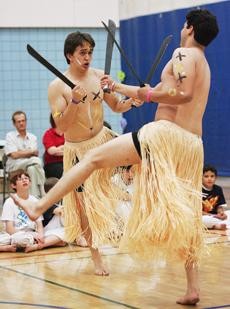Two men wearing dried grass skirts and body paint rushed toward each other, each brandishing a pair of long wooden sticks, while a semicircle of white-clad
spectators clapped.
The men began to jump, scream and strike their sticks together to the rhythm of drums, Portuguese chanting and the twang of a musical instrument called a berimbau.
This act marked the opening of Capoeira Mandinga Tucson’s 10th Batizado, held last Saturday at the UA Student Recreation Center. The event is both an initiation rite for new Capoeiristas and a graduation ceremony for current students to advance to the next level.
“”When I first started training in Capoeira, one of the things that I really loved about it was how there’s all these different kinds of movements,”” said Anne Pollack, instructor and founder of Capoeira Mandinga Tucson. “”I couldn’t imagine living without it.””
Pollack began teaching classes at the Rec Center back in 1996 and opened an academy last year at 605 E. 6th St.
Capoeira is an Afro-Brazilian martial art that started more than 400 years ago by African slaves in Brazil who masked their fighting training as a game of dance
and music.
It weaves elements of music, song, and dance together with a variety of fluid acrobatic movements including kicks, sweeps, flips, and cartwheels.
Many Capoeira masters attended the event, including Pollack’s instructor, Marcel Pereira, who began his training in 1974 in Sao Paulo, Brazil and was the third master to bring Capoeira to America. Pereira started teaching classes in San Francisco in 1984, which brought its own challenges.
“”In Capoeria, you need to have a certain atmosphere, you need to create an atmosphere that involves music, involves singing, involves understanding what the art is, and 25 years ago (Americans) really didn’t know what that was,”” Pereira said. “”I felt alone.””
The Batizado, or baptism, is an important part of Capoeira, in which every newcomer receives a nickname and their first “”corda””, a colored rope worn as a belt indicating rank, which is made from a combination of colors from the Brazilian flag, Pereira said.
Since Capoeira started, it has become an integral part of Brazilian culture.
“”It is really everywhere,”” Pereira said. “”Capoeira is the second-most practiced sport in Brazil; the first is soccer.””
Becoming a good Capoeirista requires physical and mental prowess as well as development of rhythm, said David Vick, president of the UA Capoeira Club, which sponsored the event.
“”It’s a dance, a martial art and a game. There’s a lot of strategy involved, and thinking. It’s not just like doing tricks,”” Vick said.
Vick said that his biggest challenge in Capoeira was the physical demands he faced since he began more than four
years ago.
“”For some people based on how physical they are, or how athletic they are, that’s usually the biggest hurdle. That was my hurdle at first because I was fairly skinny and disproportionate at the time,”” he said.
Despite the various obstacles a prospective Capoeirista faces, Pereira encourages them not to get discouraged.
“”Just go for it and respect your own pace. Don’t compare yourself to anybody else,”” he said. “”If you really like it, you will find a way. You keep training and, little by little, you see the way to overcome difficulties and barriers.””









